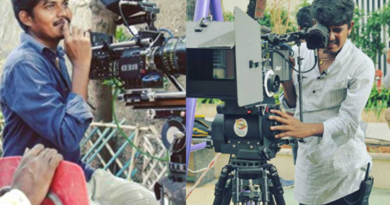Layout designer (1 years diploma course)
Layout designer click here
Brief Job Description: Individuals at this job need to design and create the digital
layouts, backgrounds, architecture and props for a production
Personal Attributes: This job requires the individual to have excellent drawing skills
including an understanding of landscapes, geographies, architecture, machinery etc.
The individual must be able to design layouts consistent with the creative style of the
production using software such as Adobe Photoshop, Gimp etc.
Qualifications Pack For Layout designer

Keywords /Terms
Description
Attitude poses Attitude poses are used to describe the body language and personality of
the characters
Budget Budget is an estimate of the total cost of production that may include a
break-up of cost components
Character line-up Character line-up is the portrayal of characters side-by-side
Character turnarounds Character turnarounds are used to depict the characters look from all
angles
Clean-up Refining the interim/rough animation
Color keys Color keys are used to depict the mood of the production through hues
and tones
color theory Color theory is the art of combining all the colors in the color wheel to
create specific color combinations
Core Skills/Generic
Skills
Core Skills or Generic Skills are a group of skills that are key to learning
and working in today’s world. These skills are typically needed in any
work environment. In the context of the OS, these include
communication related skills that are applicable to most job roles.
Creative Brief Creative brief is a document that captures the key questions that serve as
a guide for the production including the vision, objective of the project,
target audience, timelines, budgets, milestones, stakeholders etc.
Description Description gives a short summary of the unit content. This would be
helpful to anyone searching on a database to verify that this is the
appropriate OS they are looking for.

Function Function is an activity necessary for achieving the key purpose of the
sector, occupation, or area of work, which can be carried out by a person
or a group of persons. Functions are identified through functional
analysis and form the basis of OS.
Job role Job role defines a unique set of functions that together form a unique
employment opportunity in an organization.
Knowledge and
Understanding
Knowledge and Understanding are statements which together specify the
technical, generic, professional and organizational specific knowledge that
an individual needs in order to perform to the required standard.
Lighting keys Lighting keys are used to depict the mood of the production through
intensity, tine and shadows
Mouth chart Mouth chart is used to portray the emotions and expressions of the
characters
National Occupational
Standards (NOS)
NOS are Occupational Standards which apply uniquely in the Indian
context.
Occupation Occupation is a set of job roles, which perform similar/related set of
functions in an industry
Qualifications Pack For Layout designer
Occupational Standards
(OS)
OS specify the standards of performance an individual must achieve
when carrying out a function in the workplace, together with the
knowledge and understanding they need to meet that standard
consistently. Occupational Standards are applicable both in the Indian
and global contexts.
Keywords /Terms Description
NOS National Occupational Standard(s)
QP Qualifications Pack
NSQF National Skill Qualifications Framework
NVEQF National Vocational Education Qualifications Framework
NVQF National Vocational Qualifications Framework
Understanding the script
Description This OS unit is about interpreting the script/ brief/ storyboard/ concept for the
animation and design process
Scope This unit/task covers the following:
Interpret the script/ brief/ storyboard/concept correctly
Liaise with the team to improve understanding
Performance Criteria (PC) w.r.t. the Scope
Element Performance Criteria
Interpret the script/
brief/ storyboard
correctly

To be competent, the user/individual on the job must be able to:
PC1. understand the artistic and communication goals of the script, brief or
storyboard with respect to the individual’s role
PC2. be aware of the intended medium and target audience, and how this may
affect animation processes
PC3. understand the aspects related to the design brief (appearance, complexion,
dressing, moods, personalities, expressions etc.)
PC4. understand the requirements according to the scripts (number, types,
duplicates etc.) based on the individual’s role and its requirements
PC5. understand the specifications for the background and other aspects
(dimensions, operating parameters etc.) based on the individual’s role and its
requirements
PC6. understand the technical needs of the project with respect to the job role
(Television, Film, Gaming, Internet, DVD etc.)
PC7. understand the of the concept, which may be self-created, provided in a brief,
or arrived at via discussions with relevant personnel (Director, Executive
Producer etc
Liaise with the team
to improve
understanding
PC8. liaise with relevant personnel (Art Director, Producers, Animation Supervisor
etc) to better understand script elements, as appropriate
Knowledge and Understanding (K)
A. Organizational
Context
(Knowledge of the
company /
organization and
its processes)
The user/individual on the job needs to know and understand:
KA1. the creative vision and elements of production relating to the job role
KA2. the project pipeline/schedule and timelines with respect to the individual’s role
KA3. the intended purpose/ end-use of the models/ designs that need to be created
by the individual
Understanding the script
B. Technical
Knowledge
The user/individual on the job needs to know and understand:
KB1. principles of animation
KB2. how to assess the script and its artistic and communication goals
KB3. how to extract and interpret relevant information regarding the script’s vision
KB4. how to discuss and understand relevant information regarding the concept’s
vision from relevant personnel (Art Director, Producers, Animation Supervisor
etc)

KB5. how to research and tap into the sources for procuring information/
background material that will enhance understanding of the concept
KB6. applicable copyright norms and intellectual property rights
KB7. applicable health and safety guidelines
Skills (S) (Optional)
A. Core Skills/
Generic Skills
Writing Skills
The user/individual on the job needs to know and understand how to:
SA1. document notes while understanding the brief, requirements and
specifications to refer to during the production process
Reading Skills
The user/individual on the job needs to know and understand how to:
SA2. read and understand the script/ brief/ storyboard
SA3. research links, videos, artwork etc. that can be used as references
Oral Communication (Listening and Speaking skills)
The user/individual on the job needs to know and understand how to:
SA4. understand the central idea and the concept of the script
B. Professional Skills Plan and Organize
The user/individual on the job needs to know and understand how to:
SB1. analyse the tasks required and estimate the time required for each task, so as
to manage the allotted work and achieve it in given schedules
Problem Solving
The user/individual on the job needs to know and understand how to:
SB2. critically analyse the various elements of the script and the work that may be
required in relevance with the individual’s role
Decision making
The user/individual on the job needs to know and understand how to:
SB3. break down scripts in terms of major and minor locations.
Customer Centricity
The user/individual on the job needs to know and understand how to:
SB4. check that your own work meets customer/project requirements
Critical Thinking
The user/individual on the job needs to know and understand how to:
SB5. forsee the locations to be developed as per the script requirements or
updations or changes
Analytical Thinking
The user/individual on the job needs to know and understand how to:
SB6. have a keen eye for details
Ensure consistency across all scenes
Description This OS unit is about ensuring consistency across scenes in production
Scope This unit/task covers:
Understanding and noting continuity requirements
Maintaining continuity and consistency across scenes
Performance Criteria (PC) w.r.t. the Scope
Element Performance Criteria
Understanding and
noting continuity
requirements
To be competent the user/ individual must be able to:
PC1. record continuity-related details e.g. position, placement, color etc. as
required
Maintaining continuity
and consistency across
scenes

PC2. ensure that the final look is consistent with the creative requirements
agreed upon, and continuity is maintained throughout the production
PC3. ensure that designs, layouts and templates are uniform across the
production, as required
PC4. ensure that lighting, color formats and effects are consistent across the
production
PC5. check the resolution of scenes to ensure that they match the production
requirements
PC6. alert relevant personnel (Art Director, Animation Supervisor, Producer) if
continuity is not being maintained, and rectify the situation as appropriate
Knowledge and Understanding (K)
A. Organizational
Context (Knowledge
of the company /
organization and its
processes)
The user/individual on the job needs to know and understand:
KA1. the final look of the production, and the implications of this on continuity
efforts
KA2. the organizational policies regarding the final presentation of the work
products
B. Technical
Knowledge
The user/individual on the job needs to know and understand:
KB1. how to interpret the script/concept/design brief for continuity
requirements
KB2. how to note and record continuity details (e.g. the position, placement,
color of an object, the manner of interaction with the character – e.g. left
hand or right hand)
KB3. how to ensure continuity details are correctly recorded
KB4. the role of the Script/Continuity Supervisor or other relevant personnel, and
coordinating with him/her to ensure that consistency across scenes
KB5. the technical requirements of the medium in which the production will be
exhibited, and how this may affect the continuity process (eg: templates for
animation processes)
KB6. applicable health and safety guidelines
Ensuring consistency across all scenes
Skills (S) (Optional)
A. Core Skills/ Generic
Skills
Writing Skills
The user/individual on the job needs to know and understand how to:
SA1. record continuity-related details e.g. position, placement, color etc. as
required
Reading Skills
The user/individual on the job needs to know and understand how to:
SA2. read and understand the script to determine continuity requirements
Oral Communication (Listening and Speaking skills)
The user/individual on the job needs to know and understand how to:
SA3. describe and discuss the creative style with the Director, Producer or
relevant personnel to understand key concerns regarding consistency
B. Professional
Skills
Plan and Organize
The user/individual on the job needs to know and understand how to:
SB1. organize continuity details and records to easily use as a reference and spot
errors
Problem Solving
The user/individual on the job needs to know and understand how to:
SB2. identify any continuity errors and take steps to rectify them, or escalate the
issue, as appropriate
.
Decision making
The user/individual on the job needs to know and understand how to:
SB3. manage decision on suitable course of action to meet project requirements
Customer Centricity
The user/individual on the job needs to know and understand how to:
SB4. check that your own work meets customer/project requirements

Analytical Thinking
The user/individual on the job needs to know and understand how to:
SB5. ability to analyse and interpret scene in terms of: composition and subject
matter, the context in which they will be viewed or used.
Critical Thinking
The user/individual on the job needs to know and understand how to:
SB6. provide feedback on the script
Design layouts
Description This OS unit is about designing the layouts, backgrounds, architecture and props for
production in accordance to the script requirements
Scope This unit/task covers the following:
Gathering visual references that could serve as aids during the animation
process
Creating layouts for production
Performance Criteria (PC) w.r.t. the Scope
Element Performance Criteria
Gathering visual
references that could
serve as aids during
the animation process
To be competent, the user/individual on the job must be able to:
PC1. gather useful visual references, which may include: Photographs of
architectures from old to contemporary, paintings from modern masters to
contemporary, previously executed animation work-products, animations
products available in the public domain, artwork
Creating layouts for
production
PC2. create layouts for production, which may include: background visuals,
architecture, machinery, props, landscapes
PC3. conceptualize backgrounds, architecture, machinery and props designs and
draw out on different possibilities out on paper, including turnarounds, if
required
PC4. visualize the shot composition and assemble the assets – characters and
backgrounds – for each scene as per the storyboardBe aware of the
cinematographer’s point of view, and create layouts from different camera
angles, if appropriate
Knowledge and Understanding (K)
A. Organizational
Context
(Knowledge of the
company /
organization and
its processes)
The user/individual on the job needs to know and understand:
KA1. the creative vision and elements of production with respect to individual’s job
role
KA2. the profile and preferences of the target audience
KA3. the production budget and timelines with respect to the individual’s job role
KA4. the technical requirements of the medium/style in which the character will be
exhibited
KA5. the location required for the story
B. Technical
Knowledge
The user/individual on the job needs to know and understand:
KB1. how to work on image editing software such as adobe photoshop, gimp etc.
KB2. different types of landscapes, geographies and architecture
KB3. how to mark and measure sets, camera, lighting
KB4. how to photograph in high resolution for references
KB5. how to design and develop designs consistent with the creative look of the
production and in accordance to the design brief
KB6. properties and operating characteristics for different types of machinery e.g.
guns, cars, planes etc.
KB7. to create contemporary and historical architecture, furniture in various styles
as per requirements
KB8. the composition and differences in still and in moving images e.g. in textures,
surfaces, edges, depth, existence, numbers etc.
KB9. how to draw, paint and clean frame-by-frame layouts
KB10. how to represent perspective and three-dimensional spaces
KB11. how to create at least 6 applications of aspects/ aesthetics of an art
KB12. the sources for research and reference material available in the market
KB13. applicable copyright norms and intellectual property rights
KB14. applicable health and safety guidelines
Skills (S) (Optional)
A. Core Skills/
Generic Skills
Writing Skills
The user/individual on the job needs to know and understand how to:
SA1. document descriptions, to help present to the Director and Producer, and to
guide the production process
Reading Skills
The user/individual on the job needs to know and understand how to:
SA2. read and understand the design brief with respect to layout design
SA3. read and understand the camera angles, shot selection, character staging etc.
from the storyboard before providing the ideal layout
SA4. read and understand the profile and preferences of the target audience and
any culture/location-specific attributes that would need to be factored into the
design process
SA5. research links, videos, artwork etc. that can be used as references during the
production process
SA6. research various textures, chemicals, physical and biological materials to
enable presentation of the layouts in an effective manner
Oral Communication (Listening and Speaking skills)
The user/individual on the job needs to know and understand how to:
SA7. collaborate with the script team to design the backgrounds
B. Professional Skills Plan and Organize
The user/individual on the job needs to know and understand how to:
SB1. plan and prioritize work according to the requirements and agreed timelines
Problem Solving
The user/individual on the job needs to know and understand how to:
SB2. identify any creative problems that may arise during the designing of layouts
and find solutions to address them as appropriate
Decision Making
The user/individual on the job needs to know and understand how to:
SB3. finalise the creative vision of the production
SB4. be creative and imaginative
Customer Centricity
The user/individual on the job needs to know and understand how to:
SB5. be creative and imaginative as per the changes or updations in the story or
characters
Analytical Thinking
The user/individual on the job needs to know and understand how to:
SB6. be creative and imaginative as per the changes or updations in the story or
characters
SB7. have an appreciation for accuracy and pay close attention to detail
Critical Thinking
The user/individual on the job needs to know and understand how to:
SB8. be able to take direction and be prepared to make changes to your work in
response to constructive feedback
Manage and store assets
Description This OS unit is about organizing and storing the assets used in animation production,
and understanding appropriate methods by which to do so
Scope This unit/task covers the following:
Understanding appropriate asset storage methods
Organizing and storing assets
Performance Criteria (PC) w.r.t. the Scope
Element Performance Criteria
Understanding
appropriate asset
storage methods
To be competent, the user/individual on the job must be able to:
PC1. understand and research appropriate tools, techniques, technologies and
procedures for effective asset storage
Organizing and
storing assets
PC2. saving the work with appropriate names and/or naming conventions so that it
can be identified easily
PC3. storing the work in an appropriate place using appropriate storage techniques
to ensure it is protected from damage
PC4. making backup copies at appropriate time intervals of any digital files
PC5. routinely archive any work and store it securely in a second location, if required
PC6. identify and retrieve previous work from storage, as required
Knowledge and Understanding (K)
A. Organizational
Context
(Knowledge of the
company /
organization and
its processes)
The user/individual on the job needs to know and understand:
KA1. backup procedures of the organization and why they are important
KA2. relevant policies and regulations of the organization relating to asset
organization and storage
KA3. the types of assets that need to be stored and the organization’s policy
regarding the same
B. Technical
Knowledge
The user/individual on the job needs to know and understand:
KB1. the value and importance of consistent file naming conventions
KB2. the technical requirements of the medium in which the production will be
exhibited
KB3. appropriate tools, techniques, technologies and procedures for effective asset
storage
KB4. how to work on software such as Adobe Photoshop, Gimp, Coral Painter
KB5. applicable copyright norms and intellectual property rights
KB6. applicable health and safety guidelines








